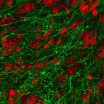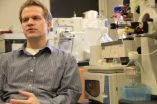Scripps scientists discover 'lubricant' for Earth's tectonic plates
Hidden magma layer could play a role in earthquakes and other aspects shaping the geological face of the planet
2013-03-21
(Press-News.org) Scientists at Scripps Institution of Oceanography at UC San Diego have found a layer of liquefied molten rock in Earth's mantle that may be acting as a lubricant for the sliding motions of the planet's massive tectonic plates. The discovery may carry far-reaching implications, from solving basic geological functions of the planet to a better understanding of volcanism and earthquakes.
The scientists discovered the magma layer at the Middle America trench offshore Nicaragua. Using advanced seafloor electromagnetic imaging technology pioneered at Scripps, the scientists imaged a 25-kilometer- (15.5-mile-) thick layer of partially melted mantle rock below the edge of the Cocos plate where it moves underneath Central America.
The discovery is reported in the March 21 issue of the journal Nature by Samer Naif, Kerry Key, and Steven Constable of Scripps, and Rob Evans of Woods Hole Oceanographic Institution.
The new images of magma were captured during a 2010 expedition aboard the U.S. Navy-owned and Scripps-operated research vessel Melville. After deploying a vast array of seafloor instruments that recorded natural electromagnetic signals to map features of the crust and mantle, the scientists realized they found magma in a surprising place.
"This was completely unexpected," said Key, an associate research geophysicist in the Cecil H. and Ida M. Green Institute of Geophysics and Planetary Physics at Scripps. "We went out looking to get an idea of how fluids are interacting with plate subduction, but we discovered a melt layer we weren't expecting to find at all—it was pretty surprising."
For decades scientists have debated the forces and circumstances that allow the planet's tectonic plates to slide across the earth's mantle. Studies have shown that dissolved water in mantle minerals results in a more ductile mantle that would facilitate tectonic plate motions, but for many years clear images and data required to confirm or deny this idea were lacking.
"Our data tell us that water can't accommodate the features we are seeing," said Naif, a Scripps graduate student and lead author of the paper. "The information from the new images confirms the idea that there needs to be some amount of melt in the upper mantle and that's really what's creating this ductile behavior for plates to slide."
The marine electromagnetic technology employed in the study was originated by Charles "Chip" Cox, an emeritus professor of oceanography at Scripps, and in recent years further advanced by Constable and Key. Since 2000 they have been working with the energy industry to apply this technology to map offshore oil and gas reservoirs.
The researchers say their results will help geologists better understand the structure of the tectonic plate boundary and how that impacts earthquakes and volcanism.
"One of the longer-term implications of our results is that we are going to understand more about the plate boundary, which could lead to a better understanding of earthquakes," said Key.
The researchers are now seeking to find the source that supplies the magma in the newly discovered layer.
INFORMATION:
The National Science Foundation and the Seafloor Electromagnetic Methods Consortium at Scripps supported the research.
END
ELSE PRESS RELEASES FROM THIS DATE:
2013-03-21
STANFORD, Calif. — The promise of repairing damaged hearts through regenerative medicine — infusing stem cells into the heart in the hope that these cells will replace worn out or damaged tissue — has yet to meet with clinical success. But a highly sensitive visualization technique developed by Stanford University School of Medicine scientists may help speed that promise's realization.
The technique is described in a study to be published March 20 in Science Translational Medicine. Testing the new imaging method in humans is probably three to five years off.
Human and ...
2013-03-21
Tampa, FL (March 20, 2013) -- University of South Florida researchers played a key role in an international multidisciplinary project that has yielded a promising new antimalarial drug with the potential to cure the mosquito-borne disease and block its transmission with low doses.
Roman Manetsch, PhD, USF associate professor of chemistry, and Dennis Kyle, PhD, USF professor of global health, were co-leaders of the USF team, which helped to discover and develop a series of potent compounds to combat malaria known as the 4-(1H)-quinolone-3-diarylethers, or quinolones.
The ...
2013-03-21
The use of words with emotional content in books has steadily decreased throughout the last century, according to new research from the Universities of Bristol, Sheffield, and Durham. The study, published today in PLOS ONE, also found a divergence between American and British English, with the former being more 'emotional' than the latter.
The researchers looked at how frequently 'mood' words were used through time in a database of more than five million digitised books provided by Google. The list of words was divided into six categories (anger, disgust, fear, joy, ...
2013-03-21
Two leading ecologists say a rapid proliferation of roads across the planet is causing irreparable damage to nature, but properly planned roads could actually help the environment.
"Loggers, miners and other road builders are putting roads almost everywhere, including places they simply shouldn't go, such as wilderness areas," said Professor Andrew Balmford of the University of Cambridge, UK. "Some of these roads are causing environmental disasters."
"The current situation is largely chaos," said Professor William Laurance of James Cook University in Cairns, Australia. ...
2013-03-21
Men who have children at older ages are more likely to have grandchildren with autism compared to younger grandfathers, according to new research. This is the first time that research has shown that risk factors for autism may accumulate over generations.
The study led by King's College London's Institute of Psychiatry, Karolinska Institutet in Sweden and the Queensland Brain Institute in Australia is published today in JAMA Psychiatry.
By using Swedish national registers, researchers identified 5,936 individuals with autism and 30,923 healthy controls born in Sweden ...
2013-03-21
(Embargoed) CHAPEL HILL, N.C. – New research from the University of North Carolina School of Medicine for the first time explains exactly how two brain regions interact to promote emotionally motivated behaviors associated with anxiety and reward.
The findings could lead to new mental health therapies for disorders such as addiction, anxiety, and depression. A report of the research was published online by the journal, Nature, on March 20, 2013.
Located deep in the brain's temporal lobe are tightly packed clusters of brain cells in the almond shaped amygdala that are ...
2013-03-21
(Boston) – Research from Boston University School of Medicine (BUSM) shows that improving vitamin D status by increasing its level in the blood could have a number of non-skeletal health benefits. The study, published online in PLOS ONE, reveals for the first time that improvement in the vitamin D status of healthy adults significantly impacts genes involved with a number of biologic pathways associated with cancer, cardiovascular disease (CVD), infectious diseases and autoimmune diseases. While previous studies have shown that vitamin D deficiency is associated with an ...
2013-03-21
More than three quarters of new, emerging or re-emerging human diseases are caused by pathogens from animals, according to the World Health Organization.
But a widely accepted theory of risk reduction for these pathogens – one of the most important ideas in disease ecology – is likely wrong, according to a new study co-authored by Stanford Woods Institute for the Environment Senior Fellow James Holland Jones and former Woods-affiliated ecologist Dan Salkeld.
The dilution effect theorizes that disease risk for humans decreases as the variety of species in an area increases. ...
2013-03-21
In the wake of last week's meetings at the UN on the definition of the Sustainable Development Goals (SDGs), a group of international scientists have published a call in the journal Nature today, arguing for a set of six SDGs that link poverty eradication to protection of Earth's life support. The researchers argue that in the face of increasing pressure on the planet's ability to support life, adherence to out-dated definitions of sustainable development threaten to reverse progress made in developing countries over past decades.
Ending poverty and safeguarding Earth's ...
2013-03-21
In the early 1950's, a 66-year-old woman, sick with colon cancer, received a blood transfusion. Then, unexpectedly, she suffered a severe rejection of the transfused blood. Reporting on her case, the French medical journal Revue D'Hématologie identified her as, simply, "Patient Vel."
After a previous transfusion, it turns out, Mrs. Vel had developed a potent antibody against some unknown molecule found on the red blood cells of most people in the world—but not found on her own red blood cells.
But what was this molecule? Nobody could find it. A blood mystery began, ...
LAST 30 PRESS RELEASES:
[Press-News.org] Scripps scientists discover 'lubricant' for Earth's tectonic plates
Hidden magma layer could play a role in earthquakes and other aspects shaping the geological face of the planet


